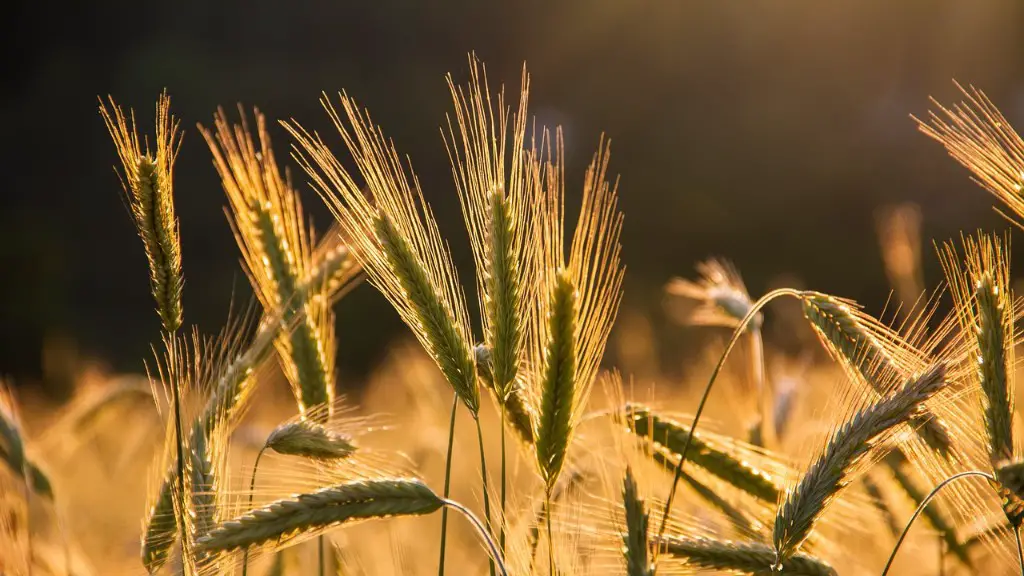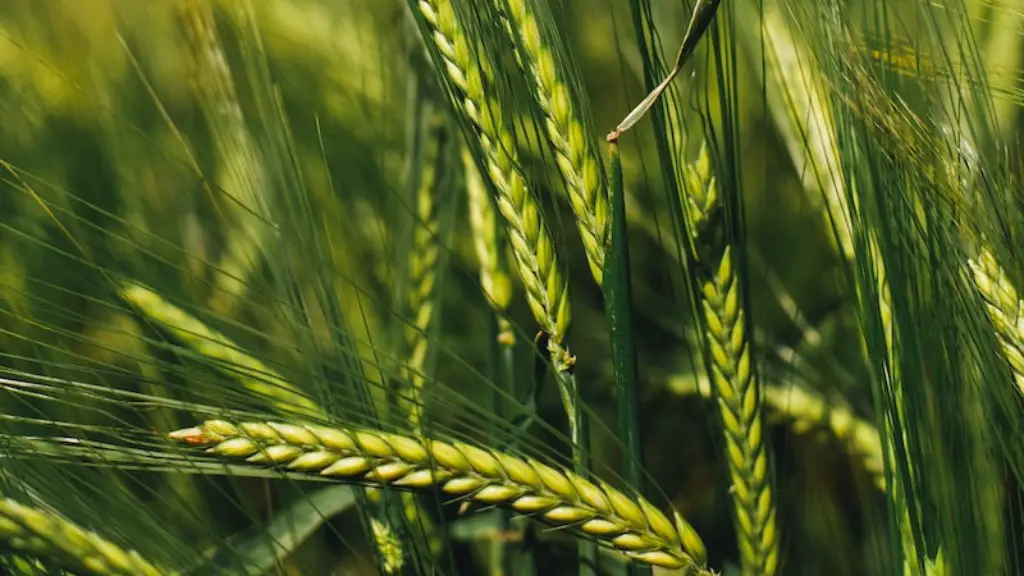Development in agriculture refers to the use of new technologies, improved management practices, andenhanced infrastructure to increase productivity and profitability in farming and ranching operations. Development can happen at the enterprise, provincial/state, or national level. It often occurs as a result of government policies or initiatives designed to promote agricultural growth. Development in agriculture has helped to raise living standards and reduce poverty in many parts of the world. It has also played a key role in global food security.
Development in agriculture involves improving the quality and yield of crops, livestock, and fisheries through the application of scientific knowledge and technology. It includes improving the efficiency of production, distribution, and marketing systems; developing and adopting new and improved production practices; and developing and adopting new and improved varieties of crops and livestock.
What is the development of agriculture?
Agriculture has been a key part of human development for millennia. The domestication of plants and animals, the development of irrigation and other methods of resource extraction, and the use of fertilizers and other inputs have allowed humans to increase the productivity of their agricultural systems. This has in turn allowed for the growth of cities and the development of civilizations.
Today, agriculture continues to play a vital role in human development. The intensification of agricultural practices has allowed us to produce more food, medicine, and other resources from a given area of land. This has helped to improve the quality of life for people around the world.
Agriculture’s impact on global trade is twofold. First, agriculture is a key sector of many economies, and its health is tied to the health of other sectors. For example, countries with strong agricultural sectors experience employment growth in other sectors, according to USAID. Second, agriculture is a key driver of global trade. Agricultural products make up a significant portion of global trade, and the sector is a major source of export earnings for many countries.
What are the examples of agricultural development
Agricultural development is a broad term that can refer to a variety of activities related to farming and ranching. These activities may include clearing and cultivating specified ground areas for crops, construction of fences to contain livestock, construction of stock ponds, and other similar agricultural activities. Agricultural development can also refer to the process of improving agricultural productivity through better management practices, technology, and infrastructure.
A strong agricultural economy is crucial for social progress in developing countries. By increasing productivity, employment and income, agriculture drives development in most rural areas. The demand for staple foods, agricultural commodities and processed food is growing in developing countries, making a strong agricultural economy essential for their continued development.
What is the most important factor for agricultural development?
Topography, soil, and climate are all important physical factors affecting agriculture. Topography can be a major obstacle to land cultivation, as well as to soil erosion and poor transport networks and facilities. Climate can also have a significant impact on agriculture, both in terms of the type of crops that can be grown and the amount of rainfall or irrigation required.
Agricultural advancement is necessary for improving the supply of raw materials for the agro-based industries especially in developing countries. The shortage of agricultural goods has its impact upon on industrial production and a consequent increase in the general price level. In order to increase the supply of agricultural raw materials, it is necessary to increase the productivity of the land by adopting modern methods of farming and by making use of better quality seeds, fertilizers, and pesticides. It is also necessary to provide farmers with better credit facilities and marketing facilities so that they are able to produce more and sell their produce at a fair price.
What is sustainable development in agriculture?
The FAO definition of sustainable agricultural development is “the management and conservation of the natural resource base, and the orientation of technological and institutional change in such a manner as to ensure the attainment and continued satisfaction of human needs for present and future generations. This definition highlights the three key pillars of sustainable agriculture: environmental stewardship, social equity, and economic viability.
Sustainable agriculture must address the needs of both current and future generations. It must be environmentally sound, socially just, and economically viable. Agricultural production must occur in harmony with the natural resource base, using methods that are gentle and non-threatening to the long-term productivity of the land. Social equity must be ensured, so that all members of society have access to the food and other benefits that agriculture provides. And finally, sustainable agriculture must be economically viable, so that it can provide a decent living for those who produce food and other agricultural products.
Growth, development, and transformation are all important aspects of a healthy and successful life. Each one of these terms can represent different things, but they all work together to help us reach our full potential.
Growth is often associated with physical changes, like getting taller or gaining muscle. But it can also refer to mental and emotional growth, like becoming more patient or adaptable. Development usually refers to progress or improvement, whether it’s in our skillset, knowledge, or abilities. Transformation is a bit different – it’s a complete change, often for the better. This could be something like quitting a bad habit, or completely changing the way you think about something.
All three of these concepts are important in our journey to becoming the best versions of ourselves. We need to constantly be growing, learning, and evolving if we want to reach our full potential.
What are stages of agricultural development
Research and product development is the first stage of innovation in agriculture. In this stage, new products or services are developed and undergo testing to ensure they are effective and meet the needs of farmers and other users. Demonstration and market validation is the second stage of innovation in agriculture. In this stage, new products or services are demonstrated to potential users and market research is conducted to validate the potential for market success. Commercialization is the third stage of innovation in agriculture. In this stage, new products or services are launched into the market and efforts are made to ensure their adoption by farmers and other users.
This is an important finding, as it suggests that agricultural productivity improvements can have a significant impact on poverty reduction. The finding that agricultural productivity has a positive impact on consumption growth for all land quintiles is also important, as it suggests that productivity improvements can benefit all households, regardless of their land ownership.
What are the four factors that contributed to the development of agriculture?
The main environmental factors that influence the extent of crop agriculture are terrain, climate, soil properties, and soil water. These factors determine which crops can be grown in specific areas.
For example, crops that require a lot of water (such as rice) can only be grown in areas with high rainfall or irrigation. Crops that can tolerate dry conditions (such as sorghum) can be grown in areas with low rainfall.
Soil type and fertility are also important considerations. Certain crops (such as wheat) require fertile soils in order to grow well, while others (such as though) can grow in poorer soils.
Finally, the terrain of an area can also influence what crops can be grown. Steep slopes, for example, may not be suitable for crops that require large amounts of flat land (such as corn).
There are four main factors of production: land, labor, capital, and entrepreneurship. These factors are essential for the creation of any good or service.
Land includes all of the natural resources that are needed to produce a good or service. This includes things like minerals, forests, and water.
Labor refers to the work that people do to produce a good or service. This can include everything from manufacturing to customer service.
Capital refers to the money that is invested in a business to help it grow and thrive. This can include things like machinery, buildings, and vehicles.
Entrepreneurship refers to the creativity and risk-taking that is needed to start and run a successful business. This can include everything from coming up with a new idea to putting in the long hours to make it all happen.
What is the development goals and strategies in agriculture
The Agriculture Development Strategy to 2025 and Vision to 2030 is a strategic instrument with a multi-sectoral approach which aims to ensure food security, produce comparative and competitive agricultural commodities, develop clean, safe and sustainable agriculture and shift gradually to the modernization of a .
In order to achieve these objectives, the strategy will focus on five main pillars:
– Strengthening food security
– Enhancing competitiveness
– Promoting sustainability
– Modernizing agriculture
– Improving governance
Each of these pillars contains a number of specific actions that need to be taken in order to achieve the overall goals of the strategy. For example, in order to strengthen food security, the strategy includes actions such as increasing productive capacity, diversifying production, and improving access to markets and information.
The Agriculture Development Strategy to 2025 and Vision to 2030 is an important step in ensuring that agriculture in the country is able to meet the challenges of the future.
The Indian government has been trying to improve the country’s agricultural productivity for many years now. One of the key initiatives in this regard has been land reform. The government has been trying to implement land reform measures across the country in order to make more productive use of the country’s land resources. Some of the measures that have been taken in this regard include:
1. Planting more densely
2. Improving irrigation facilities
3. Providing high-quality seeds
4. Implementing green methods of pest control
5. Introducing core cropping
6. Better monitoring technology
7. Improved seeds
What is difference between development and sustainable development?
The main difference between development and sustainable development is that development aims at raising the quality of life of only present generation whereas sustainable development aims at raising the quality of life of both present and future generations without threatening natural endowment and environment. In other words, development is focused on improving the quality of life of people in the here and now, while sustainable development is concerned with ensuring that future generations can enjoy the same or better quality of life, without damaging the planet.
There are a number of other key differences between the two concepts. For instance, development is often driven by economic growth, whereas sustainable development takes a more holistic view that encompasses social and environmental factors as well as economic ones. Additionally, development is often seen as a linear process, whereas sustainable development is more cyclical, in that it takes into account the need to protect and replenish natural resources.
Development can be measured in many ways including economic growth, health, education, poverty reduction, and environmental sustainability. Some economists measure development using Gross Domestic Product (GDP) per capita, which is a measure of the economic output of a country divided by its population. Other measures of development include the Human Development Index (HDI), which is a measure of health, education, and standard of living, and the Gini coefficient, which is a measure of income inequality.
There are many different theories of development, but most theorists agree that development must be holistic, considering all aspects of a society, and that it must be participatory, involving all members of a society in the process. Development must also be sustainable, meaning that it can be maintained over time without damaging the environment or putting too much strain on resources.
One of the most important things to remember about development is that it is not a linear process. There are often setbacks and setbacks and it is important to be flexible and adapt to the changing conditions. Development is an on-going process that requires continuous effort and investment.
What is growth and development in simple terms
Physical growth is the increase in size of an organism, whereas development is the growth in function and capability. Both processes highly depend on genetic, nutritional, and environmental factors. As children develop physiologically and emotionally, it is useful to define certain age-based groups. Age-based groups help doctors and other professionals understand children’s physical and emotional needs.
Development can be defined as a process of growth, new information, or an event. The transformation of a caterpillar into a butterfly is a good example of development. Development can be positive or negative, depending on the circumstances.
Warp Up
There is no one answer to this question as development in agriculture can take many forms. It could refer to improving yields through better farming techniques, introducing new crops or livestock, developing infrastructure such as irrigation systems, or increasing access to markets. In general, development in agriculture refers to any actions taken to improve the productivity and profitability of agricultural businesses.
In conclusion, development in agriculture is the process of improving the quality of agricultural products and developing new methods of food production. This process can be accomplished through research, education, and training. It is essential for the continued success of the agricultural industry and for the people who depend on it for their livelihoods.





